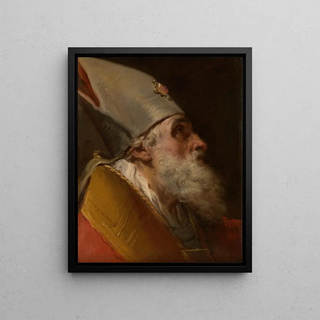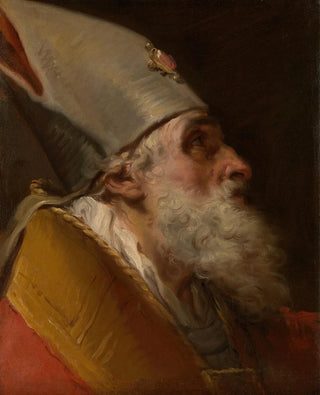Art print | Head of a Bishop - Gaetano Gandolfi


View from behind

Frame (optional)
The "Head of a Bishop" by Gaetano Gandolfi is a work that captivates with its depth and expressiveness. This portrait, evoking a religious figure imbued with wisdom and dignity, transports us into a universe where art and spirituality intertwine. As you contemplate this piece, you immediately feel the mastery of the artist, who manages to breathe soul into his subject. Light plays a crucial role in this representation, accentuating facial features and revealing emotional nuances that engage the viewer. This work is not merely a portrait; it is an invitation to explore the subtleties of the human condition through the lens of faith and tradition.
Style and uniqueness of the work
Gandolfi's style is distinguished by remarkable finesse in the treatment of textures and expressions. The "Head of a Bishop" perfectly illustrates this approach, where every detail, from the drapery of the cassock to the wrinkles of the face, is carefully crafted. The color palette, both soft and rich, helps create a contemplative atmosphere. The contrast between shadows and light emphasizes the three-dimensionality of the face, making the portrait almost alive. What makes this work unique is its ability to transcend mere visual representation to touch on emotion. The bishop, with his deep and serene gaze, seems to communicate timeless wisdom, a connection with the divine that still resonates today. Thus, the "Head of a Bishop" is not limited to a simple exercise in style but becomes a true dialogue between art and the viewer.
The artist and his influence
Gaetano Gandolfi, active at the end of the 18th century, is often regarded as a master of portraiture in Italy. Trained in the thriving artistic environment of Bologna, he knew how to draw inspiration from great masters while developing a distinctive style that is recognizable. The influence of the Bolognese school is evident in his ability to render human emotions with such intensity. Gandolfi captured the spirit of his time, when religious art and portraits of ecclesiastical figures were particularly popular.

Matte finish

View from behind

Frame (optional)
The "Head of a Bishop" by Gaetano Gandolfi is a work that captivates with its depth and expressiveness. This portrait, evoking a religious figure imbued with wisdom and dignity, transports us into a universe where art and spirituality intertwine. As you contemplate this piece, you immediately feel the mastery of the artist, who manages to breathe soul into his subject. Light plays a crucial role in this representation, accentuating facial features and revealing emotional nuances that engage the viewer. This work is not merely a portrait; it is an invitation to explore the subtleties of the human condition through the lens of faith and tradition.
Style and uniqueness of the work
Gandolfi's style is distinguished by remarkable finesse in the treatment of textures and expressions. The "Head of a Bishop" perfectly illustrates this approach, where every detail, from the drapery of the cassock to the wrinkles of the face, is carefully crafted. The color palette, both soft and rich, helps create a contemplative atmosphere. The contrast between shadows and light emphasizes the three-dimensionality of the face, making the portrait almost alive. What makes this work unique is its ability to transcend mere visual representation to touch on emotion. The bishop, with his deep and serene gaze, seems to communicate timeless wisdom, a connection with the divine that still resonates today. Thus, the "Head of a Bishop" is not limited to a simple exercise in style but becomes a true dialogue between art and the viewer.
The artist and his influence
Gaetano Gandolfi, active at the end of the 18th century, is often regarded as a master of portraiture in Italy. Trained in the thriving artistic environment of Bologna, he knew how to draw inspiration from great masters while developing a distinctive style that is recognizable. The influence of the Bolognese school is evident in his ability to render human emotions with such intensity. Gandolfi captured the spirit of his time, when religious art and portraits of ecclesiastical figures were particularly popular.






